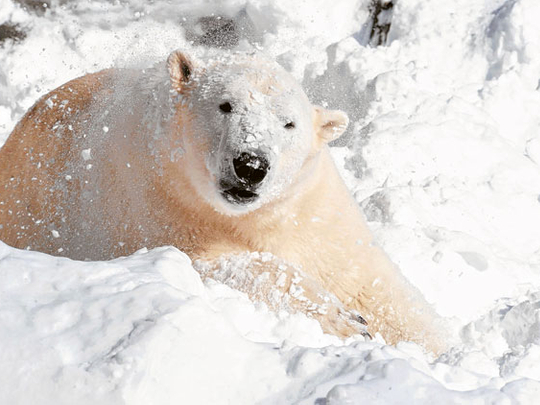
In one of the most dramatic signs ever documented of how shrinking Arctic sea ice impacts polar bears, researchers at the United States Geological Survey (USGS) in Alaska have tracked a female bear that swam nine days across the deep, frigid Beaufort Sea before reaching an ice floe 685 kilometres offshore. The marathon swim came at a cost: With little food likely available once she arrived, the bear lost 22 per cent of her body weight and her year-old female cub, who set off on the journey but did not survive, the researchers said. "Our activity data suggests that she swam constantly for nine days, without any rest. Which is pretty incredible," said George M. Durner, a USGS zoologist and a lead author of the study, published recently in the journal Polar Biology.
Polar bears spend much of their waking lives on the shifting Arctic sea ice floes. They survive mainly on the ringed seals that are also dependent on sea ice and swim in abundance in the relatively shallow coastal waters of the continental shelf. But sea ice has been melting dramatically in recent years, forcing polar bears during the autumn open-water periods to either forage from shore or swim longer distances in search of sea ice. Bears that retreat to land usually find little or no food there and "spend the duration fasting while they await the re-formation of ice needed to access and hunt seals", according to a 2008 US government study. Conservation groups, the state of Alaska, the Alaska Oil and Gas Association and several other groups are locked in litigation in Washington DC over polar bear protections and how much needs to be done to slow the pace of climate change to prevent further shrinking of their habitat.
In November 2010, the Obama administration designated more than 484,328 square kilometres along the north coast of Alaska as "critical habitat" for the polar bear but since the federal government considers the bears threatened, not endangered, there are no provisions to take steps to halt further deaths in the Beaufort and Chukchi seas.
But US District Judge Emmet G. Sullivan ruled that the federal government erred in its presumptive standard that bears must be in "imminent" danger of extinction before being considered endangered. The parties are due back in court on February 23. The difference between "threatened" and the more serious "endangered" status is crucial in this case. Attorneys for the Centre for Biological Diversity, Greenpeace and the Natural Resources Defence Council argue that an endangered finding will require the government to impose new controls on greenhouse gases across the country to protect the bears. In any case, they say, the bears are imperiled. "They're drowning and starving now, and all the scientific studies show an incredibly high likelihood of extinction of two thirds of the world's polar bears in the next 40 years ... and that includes all the bears in Alaska," said Kassie Siegel, who is arguing the case for the Centre for Biological Diversity. But Alaska Governor Sean Parnell, who is leading the charge against the Endangered Species Act protections, has said the critical-habitat designation will cost the state hundreds of millions of dollars in lost economic development and tax revenue. Plans to develop major stockpiles of offshore oil and gas resources in the Beaufort and Chukchi seas are potentially threatened by the polar bear protection zones. Additional litigation is likely on the question of how much protection must be assured for polar bears before major new drilling can proceed. Durner said it was clear that polar bears are spending more time in open water, and possibly on land, looking for food. Researchers conducting aerial surveys of the Beaufort and Chukchi seas for the Minerals Management Service in 2005 found ten polar bears swimming in open Arctic water, along with four bear carcasses floating in open water, apparently drowned. "Drowning-related deaths of polar bears may increase in the future if the observed trend of regression of pack ice and/or longer open-water periods continues," the study said.
In the case of the marathon bear, it swam in an arc north and then northeast from the Beaufort Sea coast for nine days before reaching an ice floe. "She was able to get on the surface of the sea ice for a couple of days and then she went swimming again," Durner said. But by then she was in waters almost 3,000 metres deep. "It's believed that seals do not use [these waters] as much as the waters of the continental shelf, which are maybe 90 metres deep." The bear travelled across the far-northern ice and made a beeline for the Alaska coast, almost 50 kilograms lighter than when she began.


